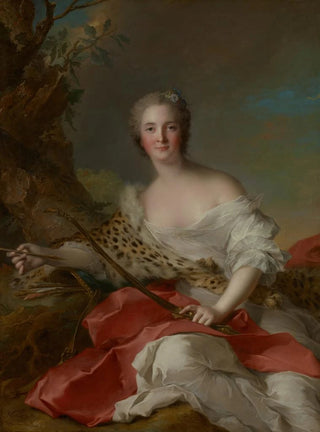Art print | Portrait of Constance-Gabrielle-Magdeleine Bonnier de la Mosson as Diana - Jean-Marc Nattier


View from behind

Frame (optional)
Portrait of Constance-Gabrielle-Magdeleine Bonnier de la Mosson as Diana - Jean-Marc Nattier – Engaging Introduction
The "Portrait of Constance-Gabrielle-Magdeleine Bonnier de la Mosson as Diana" by Jean-Marc Nattier is an iconic 18th-century artwork that embodies both the beauty and sophistication of its era. This painting, depicting the noble Constance-Gabrielle-Magdeleine Bonnier de la Mosson as the Roman goddess Diana, immerses us in a universe where art and mythology intertwine with unparalleled delicacy. Through this piece, Nattier does not merely portray a portrait; he elevates his subject to divine status, revealing the aspirations and ideals of high society at the time. This artwork, through its composition and symbolism, invites us to explore the nuances of power and femininity, while also offering a reflection on the role of women within the aristocratic context of the 18th century.
Style and uniqueness of the work
Nattier's style is characterized by refined elegance and a keen eye for detail. In this piece, soft colors and carefully orchestrated lighting create an atmosphere filled with serenity and grace. The figure of Constance-Gabrielle is draped in sumptuous fabrics, whose textures seem almost tangible, while her gaze, both penetrating and dreamy, captures the viewer’s attention. Nattier excels in portraiture, but here, he transcends the simple act of representation to offer an idealized vision of his model. The posture of the figure, slightly turned to the left, along with the natural elements surrounding her, evoke harmony between the human and the divine, between nature and culture. This painting, while celebrating feminine beauty, also raises questions about identity and representation, making it a work of great depth.
The artist and his influence
Jean-Marc Nattier, a French painter of the 18th century, is often regarded as the master of female portraiture. His work is part of the rococo movement, characterized by its taste for

Matte finish

View from behind

Frame (optional)
Portrait of Constance-Gabrielle-Magdeleine Bonnier de la Mosson as Diana - Jean-Marc Nattier – Engaging Introduction
The "Portrait of Constance-Gabrielle-Magdeleine Bonnier de la Mosson as Diana" by Jean-Marc Nattier is an iconic 18th-century artwork that embodies both the beauty and sophistication of its era. This painting, depicting the noble Constance-Gabrielle-Magdeleine Bonnier de la Mosson as the Roman goddess Diana, immerses us in a universe where art and mythology intertwine with unparalleled delicacy. Through this piece, Nattier does not merely portray a portrait; he elevates his subject to divine status, revealing the aspirations and ideals of high society at the time. This artwork, through its composition and symbolism, invites us to explore the nuances of power and femininity, while also offering a reflection on the role of women within the aristocratic context of the 18th century.
Style and uniqueness of the work
Nattier's style is characterized by refined elegance and a keen eye for detail. In this piece, soft colors and carefully orchestrated lighting create an atmosphere filled with serenity and grace. The figure of Constance-Gabrielle is draped in sumptuous fabrics, whose textures seem almost tangible, while her gaze, both penetrating and dreamy, captures the viewer’s attention. Nattier excels in portraiture, but here, he transcends the simple act of representation to offer an idealized vision of his model. The posture of the figure, slightly turned to the left, along with the natural elements surrounding her, evoke harmony between the human and the divine, between nature and culture. This painting, while celebrating feminine beauty, also raises questions about identity and representation, making it a work of great depth.
The artist and his influence
Jean-Marc Nattier, a French painter of the 18th century, is often regarded as the master of female portraiture. His work is part of the rococo movement, characterized by its taste for






